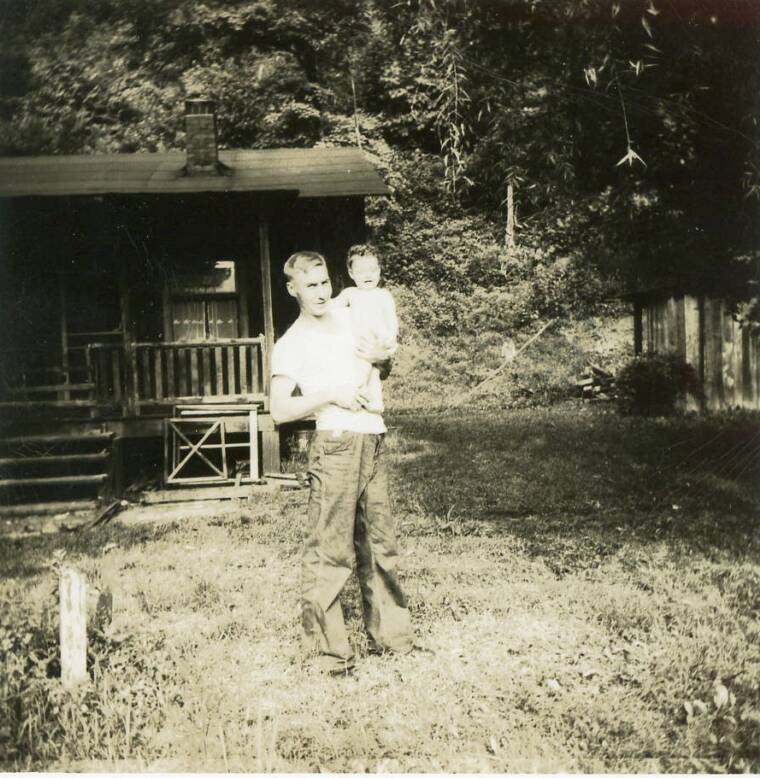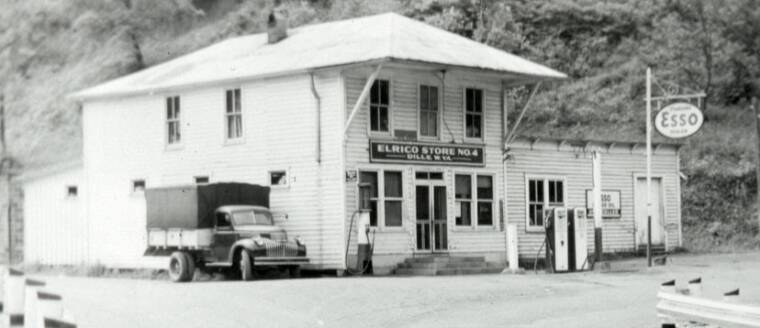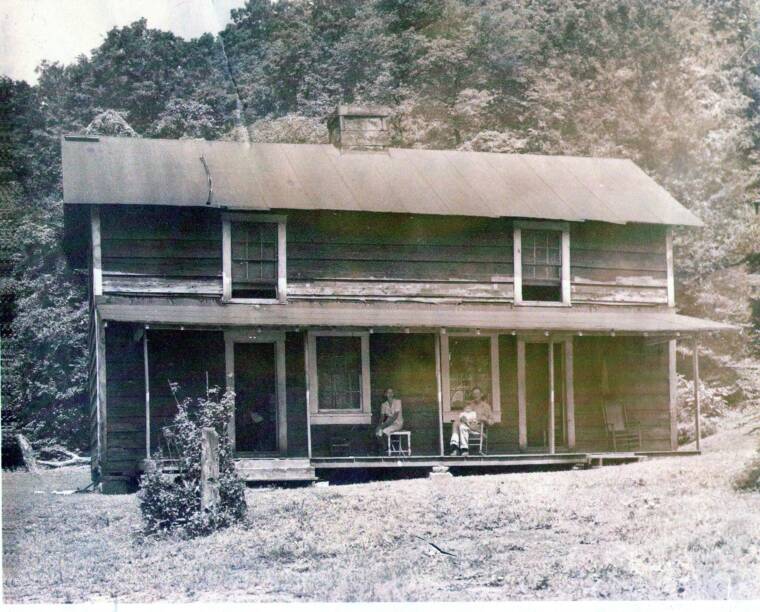OTHER
Taylor was a small community between Enoch and Widen on the south side of the railroad. According to Naomi Ashley, Taylor contained about a dozen company houses and a church. The homes were located along the Buffalo and Taylor creeks. Some of the homes had the old crank telephone on a party line to be used for company business. If you heard two short and one long ring you knew you were being called and all the phones along the line would ring.
Taylor, WV, 1949. From the collection of Naomi Ashleyy.
Naomi recalls that while Taylor was just 3 miles from Widen, to Widen residents those in Taylor were 'just country folks'. Most of the houses were small and unpainted, like the one in the photo to the right. Ben Connor, Naomi's cousin, recalls that the house they lived in was much larger with seven big rooms and sat on an acre of level ground. It had a long front porch and several out buildings.
Kids from Taylor rode a small bus to both grade school and high school in WIden.
The biggest tie between Widen and Taylor was the dam and the water being pumped from Taylor to Widen in pipes. The pump house probably stopped in the early 50s when a large water tower was erected nearer to Widen. Ben Connor recalls a large "spooky looking place with snakes and spiders that in the 1960s was still filled with large obsolete old pumping equipment", believed to be the pump house that once provided the water to Widen.
There was no train station at Taylor, but the train could be flagged there.
The photo above was provided by Naomi and shows her father, Clarence R. Hamrick (deceased) and his daughter Linda. The date is 1949. The house was heated with an iron, potty-belly stove. The 'coal house' is the building visible on the right. Naomi points out that there is a form of 'baby gate' across the opening in the porch railing near the steps...a couple of boards nailed across the opening! In the days ahead, I hope we can add more information about this community! If you have information, please send it along!
Besides the Dundon, Cressmont, Swandale and Widen, there were several other communities within the ERC&L holdings. This pages contains information that pertains to these other lesser known communities.
Taylor
Dille
Theodore Griffith now has the sign from the Dille store in his collection of BC&G memorabilia. This photo shows the sign hanging on a building on Theodore's property.
The company store at Dille was the fourth in the ERC&L. In fact, it is called No. 4 on the sign on the front (see photo below). This photo is from the collection Theodore Griffith.
Theodore Griffith, a life-long resident of Dille has provided the following description of the town:
"Dille is located 3.5 miles east north east from Widen by the hard roads, but lies only one mountain ridge east of Widen. The town was not on ERC&L Company property but was almost completely surrounded by Company land. ERC&L did mine under most of the hills surrounding Dille as well. When Widen was booming in the mid-'50s, there were about 350-400 people living in Dille and vicinity. Dille had 7 grocery stores counting the ERLRICO company store #4 (see below) and four of those stores had gasoline pumps. There were also 3 full service garages, one home hardware supply/furniture store, a post office, two churches, an elementary school, and a community building where kids could roller skate and play baskedball and where a number of civic and community clubs met and where movies were shown on Monday nights when the weather was warm. ELRICO had five mine openings (drift mouths) and one drift mine fan house in the Dille area. All but one of those drift mouths directed main line tracks out of the side of one mountain, across the narrow valley and entered the next mountain.
Today there are about 150 people living in Dille. There are no stores, no service stations, no school, no community building and no home supply store. It still retains its post office and two churches.
This 1968 photo of Dille was provided by Theodore Griffith. The is a group of houses behind the Gulf gas station in the foreground. The building next to the Gulf station facing the road was at one time a grocery store. By '68 it was a residence. The building in the background is the former ELRICO store #4. Today the service station is abandoned and the middle building is now the Dille Post Office. The company store was torn down in 1975
Three photos from Theodore Griffith collection
Strickland
Two miles west of Widen and one mile east from Taylor was the little settlement of Strickland (see map above). This wonderful painting by Judy (Workman) Dunn is of one of the houses (generally known as "the Strickland House"). The same house is shown in the 1947 photo below.
According to Lois Kinkaid, the house was built by "Doc Strickland" sometime in the late 1800's. The house was torn down in 1961. It had two large rooms on the first floor and two more on the second. It was built of logs and was later coverd by boards. A large stone central fireplace provided heat. There were two doors at the back as well as the two visible in the photo (below) of the front. It was painted red.
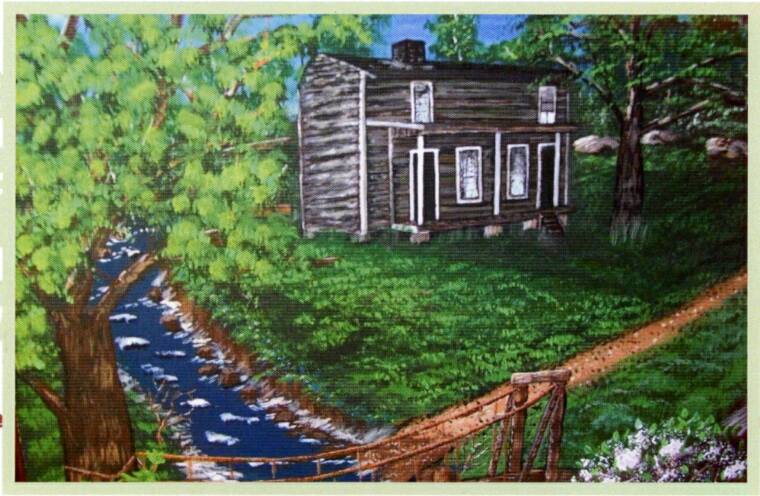
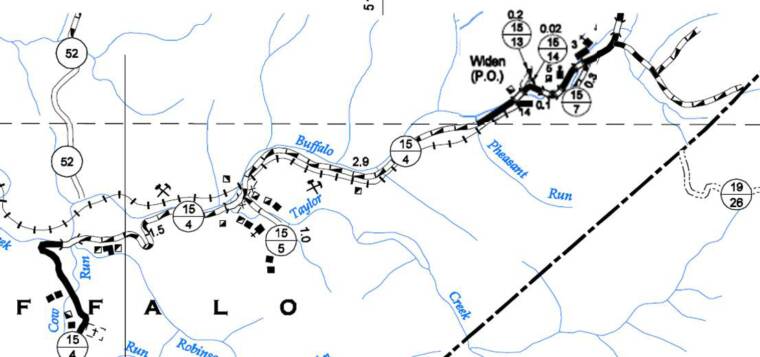
This map was provided by Naomi Ashley
TAYLOR
STRICKLAND
The Buffalo Creek is visible in the painting. The only way to get a car to the house was to drive through the creek. The dirt 'road' passing through the creek is visible in the painting. The swinging bridge appearing in the painting also crossed the Buffalo Creek. A smaller "Strickland Creek" (see yellow arrow on map above), normally just a couple of feet wide, ran behind the house.
The house was occupied by Albert and Cornelia Gill (Lois Kincaid's grandparents) up until 1948. Between 1948 and 1959 it was home to Ovalee and Ina Gill. Lois Kincaid was born in the house and lived there until she was 10 years old. It was owned by the ERC&L Co. and the Gill's paid $4/month rent. It was torn down around 1961.
The put in perspective the size of the gob pile from the Rich Run Mine, it ended just opposite this house.
The reproduction of the painting and the information about the home were provided by Naomi Ashley, Ben Conner and Lois Kincaid.
Photo provided by Lois Kincaid
According to Ovalee Gill, a former railroader for the ERC&L, both Taylor and Strickland were 'train stops".
Strickland Creek
Starcher
For information about Starcher, the logging camp on the Lilly Fork, CLICK HERE.
